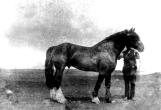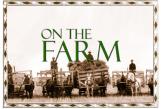1
3. On the FARM3
Horses were a basic need for those who made their living as farmers. Horses were required at every stage of farming; for plowing, seeding and harvesting crops such as wheat, oats, barley and hay.For each of these stages, a specific implement was needed. When the prairie sod had to be broken and turned over, a plow was pulled by a horse or a team of horses depending on the type of soil and the implement being used. When the crop had to be sown, horses pulled the seeders, so the seeds could drop evenly into the rows. After the crops had grown; horses pulled mowers or binders to cut the crop and then pulled the wagons or hayracks loaded with sheaves of wheat, barley or oats to the threshing machine.
Oats and hay were grown for animal feed. The hay was piled into stacks in the field or stored in barns for the horses and other animals.
5
Transcript of Eleanor Gaschnitz in conversation with Nora WoloschukHomestead Museum, 1994, Drumheller, Alberta
Nora Woloschuk: "What kind of work did they have to do to get their crops in?"
Eleanor Gaschnitz: "They used horses. Basically horses and small size machinery. A two-bottomed plough did the cultivating. We had a disc, a double disc, a tandem disc. Well that's for one set of gangs behind another. It was all horsepower up until about 1930 when we did manage to get a Titan tractor. But it was used mainly for powering the threshing machine. The basic method of power was still horses."
Nora: "How long would it take with horsepower? How long would it take to put your crop in?"
Eleanor: "It seemed as though it was forever. We didn't have very big fields. One of biggest fields was one hundred acres...perhaps it would take ten days to put your one hundred acres in. Maybe ten acres a day with your little drill."
Nora: "In those days, everybody pitched in, to put the crop in."
Eleanor: "Well, you only had so many animals, so you couldn't put two or three outfits in the field. We had one six-horse team that was about it."
6
The Joy of Riding1920
Hand Hills, Alberta
 Credits:
Credits:Photographer: Sterrie Lenfesty, Lenfesty Family Collection
7
Transcript of Harold Chambers in conversation with Nora WoloschukHomestead Museum, 1994, Drumheller, Alberta
Harold Chambers: "I can remember at a very young age, I learned to ride a horse. That was the only method of transportation, unless walking, prior to a buggy. But mainly horses. My sister and I used to ride together and go get the cows. At that time there were no fences to the east of us and the cows could wander all over.
I can remember one incident that stands out in my mind…we found the cows and we were bringing them home. And about a half-a-mile from home, there was a large size rock and we both leaned over to have a look at that rock. The saddle turned and we walked the rest of the way home…"
Nora Woloschuk: "You didn't get the saddle back on?"
Harold: "Young kids couldn't even lift the thing."
Nora: "So you couldn't ride underneath either?"
Harold: "We went the rest of the way home with the saddle dangling between the horse's legs. And she was a very patient horse…there was no objections or no trouble. Except, we thought we were in trouble."
8
Shire Horse1920
Hand Hills, Alberta
 Credits:
Credits:Photographer: Sterrie Lenfesty, Lenfesty Family Collection
9
Transcript of Harold Chambers in conversation with Nora WoloschukHomestead Museum, 1994, Drumheller, Alberta
Harold Chambers: "At a very early age I learned to drive horses."
Nora Woloschuk: "You pretty well have to be strong to drive horses too, didn't you?"
Harold: "Not necessarily. A well trained horse why it doesn't take much…"
Nora: "Much strength?"
Harold: "Much strength to steer, very little. This particular saddle horse she would…he could ride without a bridle, a neck rein. Do you know what a neck rein is?"
Nora: "Yes I do."
Harold: "Very patient."
Nora: "You didn't need an operator's to operate a horse?"
Harold: "No, you didn't need a driver's license. I started driving a binder in 1927. And being as I was fairly good at it, I never got into any stooking. My job was to drive the binder. Now our binder was an eight foot McCormick-Deering. It was kind of a little bit touchy, but if you got to understand it, it did a reasonably good day. Our seeding was done at that time with four horses on a ten foot drill. Ours was an International disc drill. And if you did twenty acres a day with this outfit, you still did a good day's work.
It was on this same drill that, I had the narrowest escape of my life. I had finished a field up only a half-a-mile from home. I was moving home, I was just about ready to pull up on the hitch and not watching exactly where I was going. One wheel went over a log that was sitting there, split the horses. And being that I was sitting on the drill box, I couldn't control them and I had a real runaway for about 400 yards. I was lucky I didn't get hurt bad, but it didn't do the drill any good."
Nora: "Were there quite a bit of accidents in those times?"
Harold: "Most accidents that happened were horse related and they got out of control of the driver. If you had a spooky horse on the team, very often they triggered the rest of them. But by and large, they weren't that numerous or that serious. There was the odd one…But by and large, I suppose you lived with it, because that was the only method you had for transportation."
10
Seeding with Horse Teams1939
Farrell Lake District, North of Delia, Alberta
 Credits:
Credits:Delia Museum Collection
11
Norvan Boon in conversation with Carrie TroutJune 2005, Drumheller, Alberta
Norvan Boon: "...seeding with four horses with a ten foot disc drill, just two wheels on each side. And I would have to walk, when you went back and forth…every time you come to an end, you would have to get over on the other side. Because you could…guide the horses closer to the last seeded round. And, I remember…then also I remember harrowing after that.
And then of course we did a lot of thrashing with horses …well when I was seventeen years old, I pitched seventeen loads into a twenty-eight inch machine that belonged to Jeff Miller. And I was only seventeen years old at that time. It was an eight team outfit but we had only five teams so we had to work our butts off in order to keep that machine running...but anyway, that fall we had to…thrashed so much at our place we had to move to another guys place everyone because everybody had to be treated the same. So we had to put a thrashing…or we had to put a team on and a pitcher on, in order to keep the dust…
And that was the year I was called to the army... and I remember being at Willie Avramenko's at the time. And it snowed that afternoon and…we slept in a grainery at that time. And, in the morning we had a snow bank across our bed. So, we had to go into the house to get our shoes. Our shoes were soaking wet…to go into the house to get our shoes thawed out so we could put 'em on and get home. And I came home I know in a snowstorm. And when I got home, then I had the call to the army."
12
Cutting Oats with a Binder at John Martin's Farm1938
Northwest of Delia, Alberta
 Credits:
Credits:Delia Museum Collection
13
Roger Pearson in conversation with Carrie TroutJune 26, 2005, Delia, Alberta
Roger Pearson: "Ya, the binder here in the picture, it cut the grain off and then elevated it up and then it went off into what they call an knotter. And the knotter tied a string around a certain amount and made it into a bundle. Then the bundle dropped onto what they called the bundle carrier and when it got, I think it was two or four on there, then you tripped that and let it off and then the fellows who were doing the stooking, put it up into stooks so it would dry out and cure then."


